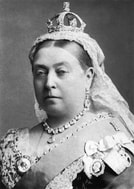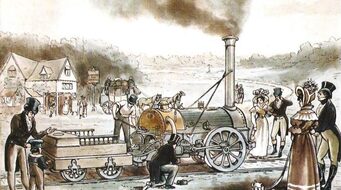10.3 - Causes and Effects of the Industrial Revolution
Innovations in agriculture, production, and transportation led to the Industrial Revolution,
which originated in Western Europe and spread over time to Japan and other regions.
This led to major population shifts and transformed economic and social systems.
Innovations in agriculture, production, and transportation led to the Industrial Revolution,
which originated in Western Europe and spread over time to Japan and other regions.
This led to major population shifts and transformed economic and social systems.
The Agrarian Revolution in England was a major breakthrough in agriculture that saw mechanization simplify farming methods and scientific improvements create food surpluses that would drastically increase the populations of Western Europe. Scientific inventions would also lead to major change as seen in the text lesson on the Industrial Revolution that is supplemented by the classroom Presentation on the Industrial Revolution in England. The examination often uses maps to focus on key events in history and the following must be learned. They are a map of the British coalfields at the time of the Industrial Revolution, a map and chart on the Growth of British Cities during the Industrial Revolution and finally a map showing the growth of British Railways. The first steam trains changed commerce and industry by improving domestic transportation and these new inventions created a great deal of social curiosity. One of my favorite ways of understanding this change is seen in the selected reading on the Liverpool to Manchester railway. The following illustrations also validate the industrial progress by looking at some of the Textile Machines in England during the Industrial Revolution and a drawing of Eli Whitney's Cotton Gin.
It would not take long for the Industrial Revolution to be copied by other countries and this link opens to a map showing the spread of the Industrial Revolution across Western Europe.
Special Assignment: Analyzing a political cartoon Capital and Labour
Special link: Hometown video
It would not take long for the Industrial Revolution to be copied by other countries and this link opens to a map showing the spread of the Industrial Revolution across Western Europe.
Special Assignment: Analyzing a political cartoon Capital and Labour
Special link: Hometown video

This age of British domination would become known as the Victorian Era, named after the British Queen. To better understand the changes that took place during her rein, this link goes to the English Heritage site and their pages offer an insight that is called An Introduction to Victorian England.
Major social, political, and economic changes will take place in this time period and they can be seen in the Liberal and Conservative Ideas during the 1800's document and the Characteristics of Early Capitalism handout. There will be uprisings within the working class who saw little financial and working benefits of industrialization. Political theories will emerge, as seen in a comparison between Communism, Socialism, and Capitalism and the major differences between Socialism and Communism. It is very important to cover these political systems at this point in time as they will be a foundation for a full understanding of future developments.
Special assignment: Understanding charts and tables covering demographics. Open the following link and analyze the chart on Populations of Western Europe from 1700 to 1850 then answer the questions that follow. Use complete sentences for each of your answers.
To end this section a global consequence of the industrial revolution is seen in the lesson on the causes and effects of the Irish Potato Famine. This is an important lesson as it is an excellent response to questions on the examination about diasporas and long distance migrations.
Special assignment: Understanding charts and tables covering demographics. Open the following link and analyze the chart on Populations of Western Europe from 1700 to 1850 then answer the questions that follow. Use complete sentences for each of your answers.
To end this section a global consequence of the industrial revolution is seen in the lesson on the causes and effects of the Irish Potato Famine. This is an important lesson as it is an excellent response to questions on the examination about diasporas and long distance migrations.
